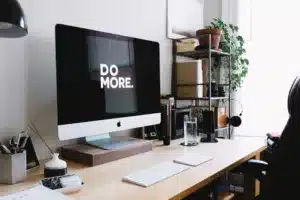It was 2am. I finished teaching at around 9pm and I was wide awake for hours as I found myself sending out invoices at 2am.
In that moment I sat there and my brain started to run. One and a half years into owning my dance studio and thought to myself, I’m sitting up at 2am doing billing and invoices and I’m thinking to myself…what’s happened?
When I first had the vision to build my dream studio, working at 2am on administrative tasks was NOT on my vision board. Was it on yours? I doubt it. Yet, why do so many of us end up being stuck doing things that:
1. Don’t grow our business
2. Don’t fulfill us or give us joy
The key to unlocking the door and escaping from admin overload, over teaching and being stuck managing loads of staff and teachers…you need to become an entrepreneur.
After working with hundreds of Dance Studio Owners, I’ve identified that there are 4 steps to getting you to the point of being an entrepreneur. Getting to this space is great as you get to do things like:
- Create new income and impact generating projects
- Spend time with your family and friends
- Travel without the studio falling apart
- Work on things that give you energy and make a big difference to your students, parents and teachers
Phase 1: Administrator
Hands up if you love administration work? (the room goes quiet and there’s nothing but crickets). It’s a shame that many studio owners can’t move through the phase of getting rid of some of the admin tasks in their business. It happens all the time, though. They think “I can’t afford to give this to someone else” when the truth is you can’t afford NOT to. You see, admin tasks like invoicing, ordering costumes, responding to basic emails, collating newsletters, liaising with recital/concert venues are low value tasks. Not that they aren’t important but in terms of money they are nothing more than $10-$20 per hour tasks. This is NOT something that the business owner should be doing. Imagine now that you get help for 5-10 hours a week to handle some admin in your business. What high value tasks could you work on as the business owner in this time? I know – marketing! You then get more hours in the week to work on growing your business and that’s what will pay for that admin person plus increase the profits in your studio.
Phase 2: Teacher
In my history of working with studio owners, I see all the time that once they start to delegate more of the admin work they begin to use these “extra” hours to teach more. One thing I know for sure is that Dance Studio Owners don’t need to teach more group classes or private lessons. I’ve been in your shoes with my own studio. I thought I can save money (expenses) by teaching more classes, which is exactly what I did. I taught about 65% of the classes over about 6 days a week. The students and parents loved it and so did I. But, is this where my limited time was best spent? NO. My week was now full to the brim of preparing for classes and teaching dance. There was a staff member in the office now so that was all great but I was teaching my little butt off which also meant retention was great but the growth of the studio (new student enrollments) had stunted.
After 12 months of this – making the same money, physically feeling exhausted (geez I was fit though!) I was like “Hold up a second…I’m working my butt off here and the business isn’t growing…what’s going on!”
When the light bulb went off I had an “A-ha” moment. Maybe I should bring in and train some teachers! So…in a very short time that’s exactly what I did. Bit by bit we had new teachers join our faculty. Now, be sure to keep in mind that I’m not suggesting you employ a whole bunch of teachers and throw them into the classes with no preparation. I’ve seen many studio owners going from complete control to no control and that’s when their business starts to fall apart.
Put a robust teacher recruitment process in place, thoroughly interview potential teachers and put them on a trial where during that time you monitor and MENTOR them.
Phase 3: Manager
So, your administration is sorted out and have teachers in place to take much of the load off. So, what’s next? You become a Manager. This phase is one that Studio Owners find challenging because managing staff is a whole different skill set and you quickly need to learn how to effectively:
- Communicate what you want (your vision and values and expectations)
- Communicate what needs improvement (have tough conversations)
- Motivate and inspire to keep staff focused and on track
During this phase there are two things that can happen:
1. You really step into the role of becoming a manager/mentor which in turn produces teachers that are all about growing their skills to pass onto the students, keeping their passion for always teaching their best class every week and committed to you and your dance families.
2. You let them do whatever they want. They rarely see you or speak with you so there’s no connection to the studio and they turn into that person who’s just showing up to get paid. If this happens, you’ll know it. You’ll start to have a high turnover of staff and this is also when teachers think they could do a better job and open up or down the road from you. A disconnected studio owner equals a demise in the business.
One Big Shift. Hopefully you’re the first example and your teachers are going great guns producing awesome results for their students and the studio as a whole. In saying that, you may have a moment like I did when you get to the end of the week and see a string of emails and messages from teachers and staff asking loads of questions, changing shifts, etc and you say “I think I need a life outside of the studio.”
So, you start the journey of finding one or two people that can manage your studio on a day to day level. A Studio Manager (operations and business/marketing) and an artistic director (classes and creative ideas) are ideal.
Tip: During the manager stage you may also have a part time marketing/sales coordinator working for you too. I highly suggest this.
Phase 4: Entrepreneur
This is where magic happens. I get goosebumps while I write this as the fourth stage is when you finally get to experience what was on your vision board when you planned to have your own dance studio.
I’ve been lucky enough to witness my clients and program members transition through these phases and I can tell you now that when you step into being the entrepreneur your life and business will shift.
Being a true entrepreneur in your studio means that you get to work on things that really light you up. You’ll spend your days working on “BIG” ideas to grow your net profit and net impact in your business. Sure, financial freedom is an outcome of reaching this stage but for me it’s about spending more time with loved ones, travelling and seeing just how much more of an impact you can make on your dance families when everything else is taken care off.
Alert: Don’t get me wrong, you’ll still work hard, but as you’ll be working on the awesome stuff it doesn’t feel like work. And YES, you will need to put out some fires along the way. This is all part of the journey and you’ll never stop learning!
Where are you?
Where are you currently in your journey to becoming an entrepreneur in your studio? What’s next? Once you work out where you are you then need to create an action plan full of all the little steps that will get you to that next stage!
Now is the time to gain clarity on your vision and what needs to be done to move you forward to reaching that place of being an entrepreneur. #doit
Clint
If you want to receive business and marketing strategies in your inbox each week to help GROW your Dance Studio, click here!
SHARE THE LOVE
[Sassy_Social_Share]

Start filling your summercamp classes now!

Build a team that’s comfortable sharing feedback, motivated to continually improve & 100% aligned with your studio’s values & mission




